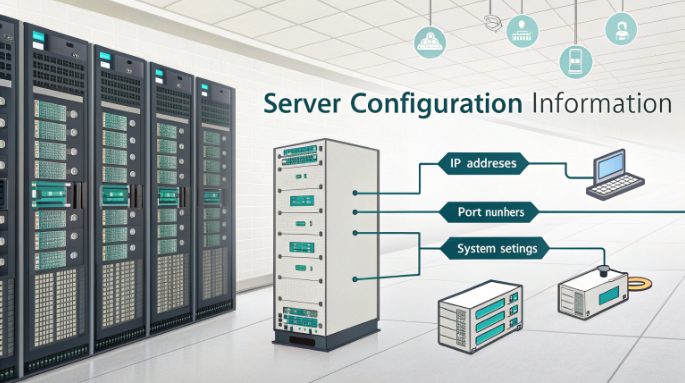How to Obtain Complete Server Configuration Information

Understanding server configuration details is crucial for IT professionals managing server hosting and colocation services, especially in tech hubs like Hong Kong. This comprehensive guide explores various methods to gather and analyze server information, ensuring optimal performance and security of your web infrastructure.
Why Server Configuration Analysis Matters
In today’s digital landscape, server configuration analysis plays a pivotal role in maintaining robust web services. Understanding your server’s setup isn’t just about knowing its specifications; it’s about ensuring optimal performance, security, and reliability of your digital infrastructure.
- Performance optimization opportunities
- Security vulnerability detection
- Resource allocation efficiency
- Compliance requirements verification
Essential Online Tools for Server Information Gathering
Modern web-based tools provide convenient ways to gather basic server information without installing specialized software. These tools offer quick insights into various aspects of server configuration.
DNS Lookup Tools
DNS lookup tools reveal crucial information about domain name systems, including:
- A records for IPv4 addresses
- AAAA records for IPv6 addresses
- MX records for mail server configuration
- TXT records for domain verification
WHOIS Services
WHOIS queries provide detailed information about domain registration and hosting infrastructure, including:
- Domain registration details
- Name server information
- IP address allocation
- Administrative contacts
Browser-Based Configuration Analysis
Web browsers offer built-in developer tools that provide valuable insights into server configurations and response patterns. These tools are essential for initial server analysis and troubleshooting.
Developer Tools Inspection
Modern browsers’ developer tools reveal:
- Response headers and server signatures
- SSL/TLS certificate details
- Content delivery metrics
- Network performance data
Network Panel Analysis
The network panel provides insights into:
- Request/response timing
- Server-side processing time
- Content compression status
- Cache control headers
Command-Line Tools for Deep Server Analysis
Command-line tools provide powerful methods for gathering detailed server information, especially useful for Hong Kong hosting environments where network configuration details are crucial.
Essential Terminal Commands
Key commands for server analysis include:
ping hostname.com traceroute hostname.com nslookup hostname.com curl -I hostname.comAdvanced Network Diagnostics
Professional-grade networking tools offer:
- MTR (My TraceRoute) for network path analysis
- Netstat for connection status monitoring
- TCPdump for packet analysis
- SS (Socket Statistics) for detailed socket examination
Professional Security Tools for Configuration Discovery
Enterprise-level security tools provide comprehensive server fingerprinting and vulnerability assessment capabilities, essential for maintaining secure colocation services.
Server Fingerprinting Tools
Professional fingerprinting tools reveal:
- Operating system version and patch level
- Web server software identification
- Application framework detection
- Server-side technology stack analysis
Port Scanning and Service Detection
Advanced port scanning provides insights into:
- Open port identification
- Service version detection
- Security protocol implementation
- Network service configuration
Hong Kong Server Configuration Specifics
Hong Kong’s unique position as a global internet hub requires specific attention to certain configuration aspects when managing hosting and colocation services.
Network Infrastructure Characteristics
Key considerations for Hong Kong servers include:
- Direct connections to major Asian networks
- Low latency routes to mainland China
- International bandwidth capacity
- Regional CDN integration capabilities
Hardware Configuration Standards
Typical hardware specifications for Hong Kong servers:
- High-performance CPU configurations
- DDR4 ECC memory requirements
- RAID storage configurations
- Power redundancy systems
Legal and Compliance Considerations
When gathering server configuration information, particularly in Hong Kong’s jurisdiction, it’s essential to understand and comply with legal requirements and best practices.
Regulatory Framework
Key compliance aspects include:
- Data privacy regulations
- Cross-border data transfer rules
- Cybersecurity requirements
- Industry-specific compliance standards
Best Practices for Information Gathering
Essential guidelines for ethical server analysis:
- Obtain necessary permissions before scanning
- Document all information gathering activities
- Respect rate limiting and access restrictions
- Maintain confidentiality of findings
Practical Implementation Tips
When implementing server configuration analysis in a production environment, consider these professional recommendations:
- Establish regular monitoring schedules
- Create baseline configuration documents
- Implement automated scanning solutions
- Maintain detailed change logs
Conclusion
Effective server configuration analysis is crucial for maintaining robust hosting and colocation services in Hong Kong’s dynamic technical landscape. By utilizing a combination of browser-based tools, command-line utilities, and professional security applications, IT professionals can ensure optimal server performance and security.
The key to successful server configuration management lies in choosing the right tools for your specific needs while maintaining compliance with local regulations. Whether you’re managing a single server or a complex hosting infrastructure, understanding these methods will help you maintain efficient and secure server operations.

